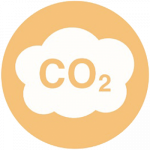
Soil Carbon
Soil organic carbon content is one of the critical indicators of a soil’s health and its ability to deliver the services we need from it – productivity, biodiversity, water quality and flood risk management.
Soils are the largest carbon reservoir of the terrestrial carbon cycle, and there is growing attention being paid to soil carbon’s impact on climate change mitigation and meeting Net Nero targets. Soils contain about three times more carbon than vegetation and twice as much as that which is present in the atmosphere.
An estimated 9.8 billion tonnes of carbon are stored in Britain’s soils, however there remains scientific uncertainty around their realisable sequestration potential - which varies according to soil and crop type, climate and other factors. A Royal Society report estimated that soil carbon sequestration could deliver 10 MtCO2 removal pa by 2050.
Where there is consensus, is around the trends pointing to decline. Analysis of the longitudinal Countryside Survey reports that arable soils in Great Britain have lost significant carbon between 1978 and 2007. While soils around the world have lost on average 26% of the carbon in the top 30 cm and 16% for the top 100 cm of soil.
There is a growing number of financial mechanisms – both public and private – being established that reflect the various ecosystem services soil carbon delivers and which incentivise farm-scale interventions that protect or enhance soil carbon – in particular for arable and grasslands where soils are most carbon-depleted.
These include better crop and nutrient management (i.e. improving varieties, cover crops, crop rotations and optimising fertiliser use), reducing tillage intensity, varying grass types, improving animal stocking density and new methods, such as growing crops with deeper roots or roots more resistant to decomposition. Certain crops can also be engineered to increase carbon fixation.
Several of these marketplaces are already operational in the UK and encouraging a global market for the storage of carbon in farmed soils is emerging with a value estimated to be c. $10tn. In 2020 Microsoft committed to including soil carbon sequestration among a portfolio of negative emission technologies it will use to remove historic emissions. They have already started buying carbon credits from agricultural projects in the US and Australia.
At the SSA, we call for:
- A holistic understanding of soil carbon’s role and function to ensure joined up policy-making and the alignment of economic interests (farmers and investors) that share a goal (soil improvement), but with different environmental outcomes in mind.
- Wherever soil carbon is considered as contributing to greenhouse gas (GHG) removals, this should not be an alternative to reductions achieved within farming or elsewhere.
- The creation of a robust, scientifically endorsed standard or protocol for the monitoring, verification and reporting of GHG removals/soil carbon sequestration, based around accurate, verified and affordable measurements of soil carbon.
- The generation of a credible and liquid UK market for long term soil carbon credits that meets the needs of farmers, investors, policy-makers and scientists.
The SSA is hosting a consortium of UK soil scientists and international carbon protocol experts looking to investigate and potentially establish a UK Farm and Soil Carbon Code that will allow standard quantification of farm carbon capture and monetisation through different incentive schemes or carbon markets.